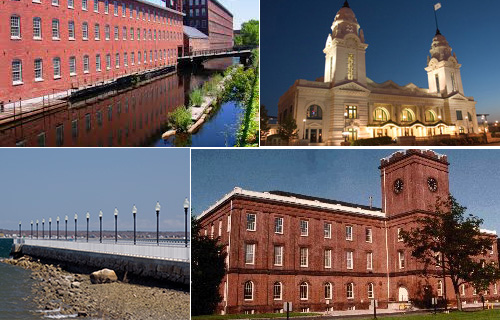Study: Continuing Decline Over Last Decade In Massachusetts’ “Middle Cities”
Read news coverage of this report in The Springfield Republican, The Brockton Enterprise, The Taunton Daily Gazette, The Worcester Telegram & Gazette, the Fitchburg Sentinel & Enterprise.
Taunton and Leominster buck the trend, see population and incomes rise, educational outcomes improve and crime decline
BOSTON – Unemployment and crime rates are higher, and per-capita income, educational performance and property values are lower than state averages in 14 Massachusetts “Middle Cities,” a subset of the state-designated “Gateway Cities,” according to a study published by Pioneer Institute.
In “Ten Years Later: Trends in Urban Redevelopment,” author Aaron Beitman updates a 2006 study of 14 Massachusetts cities with populations of more than 40,000 and average per-capita annual incomes of below $25,000 (Pittsfield is the one city in the study in which per-capita income is greater than $25,000).
“The Commonwealth has increasingly become a tale of two states—where the Greater Boston area thrives while historic urban centers to the north, south and west face huge economic and social challenges,” said Jim Stergios, executive director at Pioneer Institute. “We provided this snapshot of how the Middle Cities are doing to underscore the need for a sense of urgency in implementing policies that improve education, financial, public safety and management outcomes in these cities.”
Per-capita income in the Middle Cities is between 31 percent and 66 percent below the statewide average and has been falling for over 30 years. It was 82 percent of the state average in 1979, but fell to 53 percent by 2009.
The story is similar for median household income. It averages between $30,000 and $50,000 annually in the 14 cities; 12 to 53 percent below the state average of $66,866 from 2009 to 2013.
When it comes to educational achievement, all 14 cities underperform state averages on MCAS. In 2015, 91 percent of Massachusetts students scored “Advanced” or “Proficient” on MCAS English language arts tests, compared to between 67 percent and 89 percent in Middle Cities. In math, more than 15 percent of Middle Cities’ students scored in the “Warning/Failing” category—nearly double the state average.
The dropout rate in Middle Cities is nearly twice the state average and students attend college at a lower rate.
In terms of equalized valuation, which compares the value of property assets, state values grew at an annual rate of 7.92 percent between 1992 and 2012. During the same period, Middle Cities’ property values rose by 2.66 percent annually, just over one-third the statewide growth rate.
In the aggregate, population in the 14 cities fell by 0.3 percent from 1970 to 2013, while the state population grew by 17.6 percent. The level of population decline is especially alarming in western Massachusetts, where Chicopee, Holyoke and Pittsfield saw decreases of 16.4 to 22.7 percent.
Despite these troubling overall findings, Taunton and Leominster were the clear top performers among the 14 cities. They have seen rising populations, higher per-capita and median household incomes, lower crime rates and better educational outcomes over the last decade. A deeper examination of how Taunton and Leominster have achieved success would greatly inform economic development policy in Massachusetts.
About the Author
Aaron Beitman holds a Ph.D. in political science from the University of Minnesota and a Master’s degree from Georgetown University.
About Pioneer
Pioneer Institute is an independent, non-partisan, privately funded research organization that seeks to improve the quality of life in Massachusetts through civic discourse and intellectually rigorous, data-driven public policy solutions based on free market principles, individual liberty and responsibility, and the ideal of effective, limited and accountable government.



